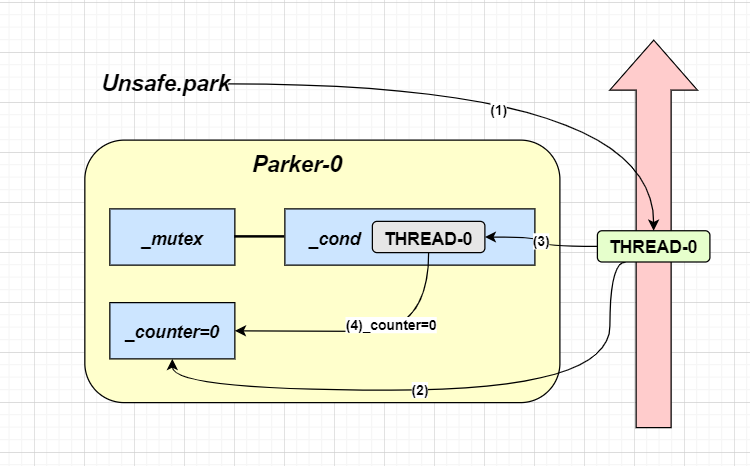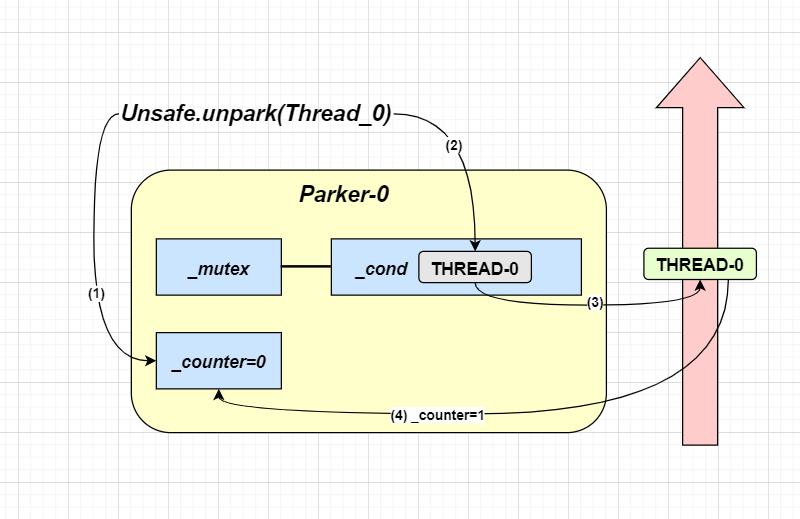Park/Unpark原理
08 Feb 2020 -
3 minute read
Park & Unpark
基本使用
// 暂停当前线程
LockSupport.park();
// 恢复某个线程的运行
LockSupport.unpark(暂停线程对象)
先 park 再 unpark
Thread t1 = new Thread(() -> {
log.debug("start...");
sleep(1);
log.debug("park...");
LockSupport.park();
log.debug("resume...");
},"t1");
t1.start();
sleep(2);
log.debug("unpark...");
LockSupport.unpark(t1);
// output
18:42:52.585 c.TestParkUnpark [t1] - start...
18:42:53.589 c.TestParkUnpark [t1] - park...
18:42:54.583 c.TestParkUnpark [main] - unpark...
18:42:54.583 c.TestParkUnpark [t1] - resume...
先unpark再park
Thread t1 = new Thread(() -> {
log.debug("start...");
sleep(2);
log.debug("park...");
LockSupport.park();
log.debug("resume...");
}, "t1");
t1.start();
sleep(1);
log.debug("unpark...");
LockSupport.unpark(t1);
// output
18:43:50.765 c.TestParkUnpark [t1] - start...
18:43:51.764 c.TestParkUnpark [main] - unpark...
18:43:52.769 c.TestParkUnpark [t1] - park...
18:43:52.769 c.TestParkUnpark [t1] - resume...
与 Object 的 wait & notify 相比
- wait,notify 和 notifyAll 必须配合 Object Monitor 一起使用,而 park,unpark 不必
- park & unpark 是以线程为单位来【阻塞】和【唤醒】线程,而 notify 只能随机唤醒一个等待线程,notifyAll 是唤醒所有等待线程,就不那么【精确】
- park & unpark 可以先 unpark,而 wait & notify 不能先 notify
原理
Unsafe类的park/unpark是native级别的实现。使用native关键字说明这个方法是原生函数,也就是这个方法是用C/C++语言实现的,并且被编译成了DLL,由java去调用。
每个线程都有自己的一个 Parker 对象,由三部分组成 _counter , _cond 和 _mutex
打个比喻:
- 线程就像一个旅人,Parker 就像他随身携带的背包,条件变量就好比背包中的帐篷。_counter 就好比背包中 的备用干粮(0 为耗尽,1 为充足)
- 调用 park 就是要看需不需要停下来歇息
- 如果备用干粮耗尽,那么钻进帐篷歇息
- 如果备用干粮充足,那么不需停留,继续前进
- 调用 unpark,就好比令干粮充足
- 如果这时线程还在帐篷,就唤醒让他继续前进
- 如果这时线程还在运行,那么下次他调用 park 时,仅是消耗掉备用干粮,不需停留继续前进
- 因为背包空间有限,多次调用 unpark 仅会补充一份备用干粮
public static void park() {
UNSAFE.park(false, 0L);
}
public static void unpark(Thread thread) {
if (thread != null)
UNSAFE.unpark(thread);
Unsafe类实现:
//park
public native void park(boolean isAbsolute, long time);
//unpack
public native void unpark(Object var1);
在Linux系统下,park和unpark是用的Posix线程库pthread中的mutex(互斥量),condition(条件变量)来实现的。简单来说,mutex和condition保护了一个叫_counter的信号量。当park时,这个变量被设置为0,当unpark时,这个变量被设置为1。当_counter=0 时线程阻塞,当_counter>0直接设为0并返回。
每个Java线程都有一个Parker实例,Parker类部分源码如下:
class Parker : public os::PlatformParker {
private:
volatile int _counter ;
...
public:
void park(bool isAbsolute, jlong time);
void unpark();
...
}
class PlatformParker : public CHeapObj<mtInternal> {
protected:
pthread_mutex_t _mutex [1] ;
pthread_cond_t _cond [1] ;
...
}
由源码可知Parker类继承于PlatformParker,实际上时用Posix的mutex,condition来实现的。Parker类里的_counter字段,就是用来记录park和unpark是否需要阻塞的标识。
执行过程
具体的执行逻辑已经用注释标记在代码中,简要来说,就是检查_counter是不是大于0,如果是,则把_counter设置为0,返回。如果等于零,继续执行,阻塞等待。
void Parker::park(bool isAbsolute, jlong time) {
//判断信号量counter是否大于0,如果大于设为0返回
if (Atomic::xchg(0, &_counter) > 0) return;
//获取当前线程
Thread* thread = Thread::current();
assert(thread->is_Java_thread(), "Must be JavaThread");
JavaThread *jt = (JavaThread *)thread;
//如果中途已经是interrupt了,那么立刻返回,不阻塞
// Check interrupt before trying to wait
if (Thread::is_interrupted(thread, false)) {
return;
}
//记录当前绝对时间戳
// Next, demultiplex/decode time arguments
timespec absTime;
//如果park的超时时间已到,则返回
if (time < 0 || (isAbsolute && time == 0) ) { // don't wait at all
return;
}
//更换时间戳
if (time > 0) {
unpackTime(&absTime, isAbsolute, time);
}
// Enter safepoint region
// Beware of deadlocks such as 6317397.
// The per-thread Parker:: mutex is a classic leaf-lock.
// In particular a thread must never block on the Threads_lock while
// holding the Parker:: mutex. If safepoints are pending both the
// the ThreadBlockInVM() CTOR and DTOR may grab Threads_lock.
//进入安全点,利用该thread构造一个ThreadBlockInVM
ThreadBlockInVM tbivm(jt);
// Don't wait if cannot get lock since interference arises from
// unblocking. Also. check interrupt before trying wait
if (Thread::is_interrupted(thread, false) || pthread_mutex_trylock(_mutex) != 0) {
return;
}
//记录等待状态
int status ;
//中途再次检查许可,有则直接返回不等带。
if (_counter > 0) { // no wait needed
_counter = 0;
status = pthread_mutex_unlock(_mutex);
assert (status == 0, "invariant") ;
// Paranoia to ensure our locked and lock-free paths interact
// correctly with each other and Java-level accesses.
OrderAccess::fence();
return;
}
OSThreadWaitState osts(thread->osthread(), false /* not Object.wait() */);
jt->set_suspend_equivalent();
// cleared by handle_special_suspend_equivalent_condition() or java_suspend_self()
assert(_cur_index == -1, "invariant");
if (time == 0) {
_cur_index = REL_INDEX; // arbitrary choice when not timed
//线程条件等待 线程等待信号触发,如果没有信号触发,无限期等待下去。
status = pthread_cond_wait (&_cond[_cur_index], _mutex) ;
} else {
_cur_index = isAbsolute ? ABS_INDEX : REL_INDEX;
//线程等待一定的时间,如果超时或有信号触发,线程唤醒
status = os::Linux::safe_cond_timedwait (&_cond[_cur_index], _mutex, &absTime) ;
if (status != 0 && WorkAroundNPTLTimedWaitHang) {
pthread_cond_destroy (&_cond[_cur_index]) ;
pthread_cond_init (&_cond[_cur_index], isAbsolute ? NULL : os::Linux::condAttr());
}
}
_cur_index = -1;
assert_status(status == 0 || status == EINTR ||
status == ETIME || status == ETIMEDOUT,
status, "cond_timedwait");
_counter = 0 ;
status = pthread_mutex_unlock(_mutex) ;
assert_status(status == 0, status, "invariant") ;
// Paranoia to ensure our locked and lock-free paths interact
// correctly with each other and Java-level accesses.
OrderAccess::fence();
// If externally suspended while waiting, re-suspend
if (jt->handle_special_suspend_equivalent_condition()) {
jt->java_suspend_self();
}
}
unpark直接设置_counter为1,再unlock mutex返回。如果_counter之前的值是0,则还要调用pthread_cond_signal唤醒在park中等待的线程。

- 当前线程调用 Unsafe.park() 方法
- 检查 _counter ,本情况为 0,这时,获得 _mutex 互斥锁
- 线程进入 _cond 条件变量阻塞
- 设置 _counter = 0

- 调用 Unsafe.unpark(Thread_0) 方法,设置 _counter 为 1
- 唤醒 _cond 条件变量中的 Thread_0
- Thread_0 恢复运行
- 设置 _counter 为 0